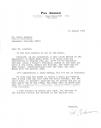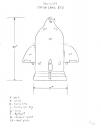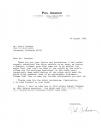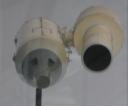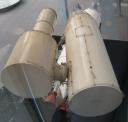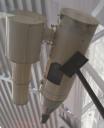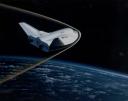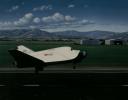A grocery trip yesterday got extended a bit, and took me here:
Before I started Aerospace Projects Review, I had taken a few stabs are writing other, somewhat similar, aerospace history items. One of the earliest – and in retrospect, least sensible – ideas was to write a massively illustrated book on the Orion nuclear pulse concept. This was not a good idea at the time, because there was virtually nothing of value available on the design of Orion vehicles. That information was not to become available for a few more years yet.
Nevertheless, one of the chapters in my little Orion book was going to be about fictional depictions of Orion. One of these depictions was in Poul Andersons book “Orion Shall Rise.” Sadly, the book did not include technical schematics (a common failing amongst most novels, in fact). But I managed to get in touch with Mr. Anderson, explain my project, and trade a few things back and forth. One of the things he sent me was a pencil sketch of the Orion Shall Rise ship. I made a simple 3-D computer model of it at the time, and suggested a few minor changes; these files and illustrations have long since been lost. However, I still have Mr. Andersons letters and the sketch, so… here ya go.
On display in Seattle Museum of Flight, a Boeing “Manned Orbiting Telescope” model. This looks like nothing so much as a MOL nailed to the Hubble. I’ve seen MOT designs before; they were invariably “man tended” concepts; having a manned spacecraft actually docked to the telescope while the scope is working would be grade-A nuttery. Humans bumping around, fans buzzing, pumps banging back and forth… all would contribute to really very bad astronomy. Consequently, I can only assume that the MOL here was intended to not be permanently attached, but instead just floating nearby. When the scope needs maintenance – such as swapping out film cannisters – the MOL sidles up, docks on and the repairman does his thing… then leaves.
Not shown was how the MOT was to be powered. Solar power, presumably, but no panels were included.
With MOL being a USAF project… you can bet that there’d be one or two MOTs with slightly different optics… and forever pointed down.
On display at the Patton tank museum at Fort Knox, Kentucky is the T28. This monster was designed during WWII to trundle up to Nazi fortifications and blast the bejeebers out of ’em, but was too late to see service. It was so massive that it required four treads, and even then it likely would have sunk in the mud. Even so, at 95 tons it was only about half the weight of the German Maus tank. And don’t even get me started on the “Ratte…”
Ah, the wonders wrought by evolution.
http://www.woai.com/content/health/story.aspx?content_id=960409d2-bf48-42a2-860d-ef18135fa355
According to doctors at UCSD Medical Center, rattlesnake venom in southern California appears to have gotten much more potent over the past two years, especially this year.
While it’s always interesting to see natural selection in action, not everybody is goign to be thrilled to hear this news….

More on the HL-20, by way of NASA artwork. These were painted back in the days when artists used actual paint. Nowdays the same sort of art would be done on computer. CG art looks fine, but concept art that’s actually painted just looks a whole lot better to me for some reason.
SUBTLE HINT: If you like what I’m posting, please feel free to Buy My Stuff. Or just plain Give Me Money.
Photos of a Boeing Manned Orbiting Laboratory (MOL) model on display at the Seattle Museum of Flight.
SUBTLE HINT: If you like what I’m posting, please feel free to Buy My Stuff. Or just plain Give Me Money.






